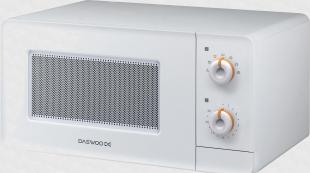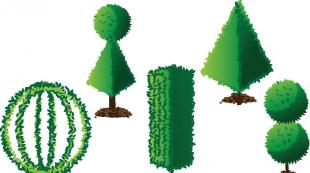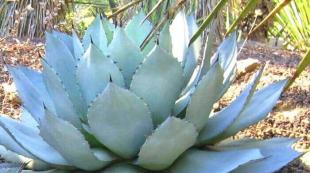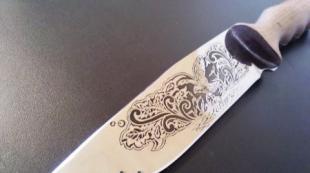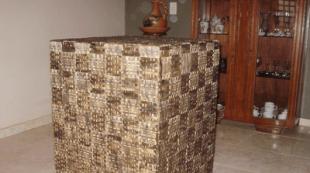Choosing a cultivator for the soil. Motor cultivators - which one to choose What does a cultivator on a tractor consist of
The carburetor is designed for the preparation (carburetion) of a combustible mixture outside the engine cylinder. The diagram of the simplest carburetor is shown in Figure 1.
The working process of the simplest carburetor is as follows. During the intake stroke, a vacuum is created in the engine cylinder, which is transferred to the mixing chamber of the carburetor, as a result of which air is sucked into it.
The air entering the carburetor passes through a narrow section of the diffuser 7, as a result of which its speed increases. For this reason, the vacuum increases even more in the narrow part of the diffuser, due to which the fuel is atomized, flowing from the float chamber through the atomizer 4 into the mixing chamber, where it mixes with air. The amount of combustible mixture is regulated by throttle valve 11.
The composition of the combustible mixture prepared in the carburetor can be changed by opening the air damper 6. A mixture in the proportion of 1 g of gasoline to 15 g of air is called normal. With an excess of air, the mixture in a ratio of 1:15 ... 17 is called depleted. With a lack of air, a mixture of 1:13 ... 15 is called enriched.
However, the simplest carburetor cannot provide the required composition of the combustible mixture at various operating conditions of the engine, since it prepares a normal mixture only at a constant crankshaft speed and open throttle. Therefore, carburetors are installed on engines, supplemented with special devices and devices - dosing systems.
Question 2. Cultivators: purpose, types, device, workflow. [ 1 ]
Cultivation is loosening the soil while cutting weeds and fertilizing. The tools used to perform this operation are called cultivators.
The classification of cultivators is as follows:
by appointment: for continuous tillage ( steam), inter-row tillage ( tilled) And special purpose;
according to the method of connection with the tractor: hinged And trailed.
They are used mainly for pre-sowing processing.
Continuous cultivation is used to kill weeds and loosen the soil when caring for fallows and preparing for sowing. It should be carried out across the previous processing or at an angle to it at a speed of 9 ... 12 km / h, since with an increase in speed, the leveling of the field surface improves and good conditions are created for the operation of sowing machines.
Trailed cultivator KPS-4G designed for pre-sowing tillage and fallow treatment with simultaneous harrowing at a speed of 10…12 km/h. The width of the cultivator is 4 m, the working depth is up to 12 cm.
Device (Fig. 2): the main assembly unit is the frame 13, based on two support wheels 14. Working bodies are attached to the frame with the help of ridges 10 with rod mechanisms 2 - lancet paws on racks 15. The frame with the help of a towing device, consisting of a central drawbar 7 and two drawbars 6 and 11, as well as trailing eye 9 is attached to a tractor of traction class 1.4 or 2.

1 - link tooth harrow; 2 - rod with a spring; 3 - hinge bracket;
4 – hydraulic cylinder; 5 – rod of the hydraulic system; 6 - left rib;
7 - central thrust; 8 - rod holder; 9 - trailer earring; 10 - beds;
11 - right eye; 12 - footrest; 13 - frame; 14 - support wheel;
15 - lancet paws
Figure 2 - Cultivator KPS-4G
The lancet paws are designed for cutting weeds, and the loosening paws on S-shaped racks with spikes at their ends are for loosening the soil.
The designs of the working bodies of trailed cultivators for continuous tillage with a diagram of their arrangement are presented in Annex 4.
Working process: the frame is lowered to the surface of the field with the help of a hydraulic cylinder 4 with the deepening of the working bodies to a predetermined depth. When driving AIT buried working bodies cut the rhizomes of weeds and loosen the soil.
The cultivator is aggregated with class 1.4 tractors. The productivity of the unit is up to 4.2 ha/h at an operating speed of 10 km/h.
Row cultivators are intended for processing row-spacings of crops of potatoes, beets, cabbage, tomatoes and other crops. At the same time, they can apply mineral fertilizers directly into the row or at a distance of up to 12 cm from it. During inter-row cultivation, weeds in the aisles are destroyed, and the water-air regime of plant nutrition is also improved. Row spacing and plant feeding are carried out with the help of the working bodies of cultivators.
Mounted cultivator-hiller KOH-2.8 designed for inter-row cultivation and top dressing of potatoes planted with four-row planters.
The device (Fig. 3): four sections with working bodies 10 and fertilizer spreaders 6 are attached to the transverse beam-frame 1, resting on wheels 18. For aggregation with a tractor, an automatic coupler lock 7 is welded to the beam-frame.

1 - bar-frame; 2 - bracket; 3 - upper link; 4 - chain drive;
5 – seeding regulator; 6 - fertilizer sowing apparatus; 7 – coupler lock;
8 - foot board; 9 - marking plate; 10 - working bodies;
11, 12 - holders; 13 - fertilizer duct; 14 - beds; 15 - bar;
16, 18 - wheels; 17 - lower link
Figure 3 - Cultivator-hiller KOH-2.8 A
The section of working bodies is attached to the frame by means of a four-link parallelogram mechanism, which, when lowering the wheel of section 16 on uneven soil, ensures parallel movement of the ridges 14, thereby maintaining the constancy of the angles of inclination of the working bodies and the depth of processing.
Depending on the operations performed, certain working bodies can be installed on the sections ( cm. Appendix 5), as well as fertilizing devices for applying mineral fertilizers.
Working process: the formation of ridges along the rows of seedlings of potatoes (hilling up) is performed simultaneously in four rows of body-hillers 10. On the racks of the body-hillers, burrs and double-sided dumps with sliding wings are attached. The soil, cut with a burr, rises along the working surface of the dump, loosens and rakes up to the rows of plants. As a result, ridges up to 25 cm high are formed.
At the same time, plants are fed with mineral fertilizers using a feeding device. The disks of the fertilizer spreaders 6 are driven from the support wheels 16 through a gear-chain transmission. As a result, mineral fertilizers enter the funnels of the dressing knives and fertilizer lines. The knives plant the fertilizer into the soil up to a depth of 16 cm.
Mounted cultivator-hiller is aggregated with MTZ-80, 82 tractors.
Cultivators are widely used in private farms and farm enterprises. But this type of technology has its own internal division. It is necessary to pay attention to it both when buying and during operation.


Mass classification
It is gravity that is one of the main criteria for sorting cultivators. Their weight can vary from 9 to 40 kg. Even women and high school students can easily handle the lightest cars. Not every professional farmer can handle the most difficult ones. The ultra-light category includes motor cultivators, the mass of which does not exceed 15 kg, and the engine produces a maximum of 1.5 liters. With.
Important: some manufacturers in this category include mechanisms with a weight of up to 20 kg, capable of developing power up to 3 liters. With. Therefore, it is necessary to clarify this point every time.
Ultra-light cultivators can loosen the earth no more than 8 cm. They are recommended for use in flower beds, flower gardens and similar purposes. Due to the small working width (not exceeding 30 cm), cultivators of this type can process even narrow row-spacings and hard-to-reach places.

The power plant in them operates either in two-stroke or four-stroke mode. The second option is preferable. As for light cultivators, this group includes machines weighing no more than 40 kg, capable of developing power up to 4.5 liters. With. Increasing the capture width to 40-50 cm immediately expands the possibilities of farmers. After all, the overall performance increases by 50-100% (compared to ultralight devices).
If you install a small hiller, you can easily and quickly cut furrows for planting any plants. But we must remember that light cultivators can "bounce" when entering the ground. Their mass is not enough to stably stay in one position. Cultivators of the middle category have a mass of 45 to 60 kg. They are equipped with motors with a total power of 4 to 6 liters. With.


In addition to increasing stability, such machines are good due to the larger swept lane. The depth of cultivation of the earth is increasing - it can reach 25-28 cm. But it is worth considering that in narrow places and in hard-to-reach areas such equipment does its job poorly. On medium cultivators, four-stroke engines are usually installed. It is allowed to use both hillers and small plows.
The heavy class includes motor cultivators that weigh over 60 kg and develop a power of 6 hp. With. and more. All such machines are equipped by default with four-stroke engines and a full-fledged gearbox. This helps to increase the functionality of the technique. The available range of trailers and attachments is expanding. Even the processing of large vegetable gardens becomes possible.

Variety by purpose
But mass is not everything. The combined type of cultivators, thanks to the careful study by the designers, can simultaneously do several agricultural work at once. Almost all of these machines have a solid frame and are highly productive. With the help of such motor cultivators, it is possible to redo the soil structure in a certain area in the shortest possible time.
However, the correct choice of device power is of great importance.
Combined cultivators are produced by both domestic and foreign factories. Along with this technique, the inter-row option has become widespread. The creation of such cultivators was a deep breakthrough in personal subsidiary plots.
With their help, you can:
- loosen;
- feed;
- weed the earth.


Some inter-row cultivators are able to fertilize vegetable plantings simultaneously with the processing of gaps. The differences relate to the width of the processed strip and the depth of loosening. Some models can apply liquid top dressings to the ground, and not just solid fertilizers. You can also purchase devices that loosen the ground and cut weeds. It is useful to use versions with protective discs - they do not damage the plants.
For the processing of potatoes, special varieties of cultivators are designed. If you use them, you can loosen the earth, and break up large lumps, and make the soil horizon smoother. Thanks to such manipulations, the roots of the bushes are supplied with oxygen more efficiently, and moisture retention is increased.
Important: if the soil is very difficult, it sometimes has to be loosened in several stages.

Judging by the estimates of practitioners, the processing of potato fields by cultivators increases the yield by up to 3 times, while the total time of field work is reduced by at least 2 times.
Special attention deserves such a type of equipment as a subsoiler. With its help, the soil is loosened deeply (which follows from the name itself), but the layers do not turn over. As a result, the supply of oxygen and nitrogen improves. When using a subsoiler, you can increase the yield. These devices are suitable for the cultivation of almost all agricultural plants used in Russia. Subsoilers can be equipped with additional attachments that allow you to fertilize the soil and perform other manipulations.
A seeder-type cultivator is also a fairly common option. It allows you to carry out continuous sowing of grains of cereals and leguminous plants, while cutting weeds. These functions are harmoniously combined with the addition of granular mixtures and with the rolling of the earth in strips. Such processing is optimal in places where moisture is insufficient, as well as in areas where the land is severely damaged by wind erosion.
Modern products can work effectively in fields where crop residues are stored.

The differences between the models relate to:
- hourly productivity (measured in hectares);
- working speed;
- the width of the captured strip;
- capacity of seed and fertilizer hoppers.
A weeder cultivator can be of great benefit. Along with the operation indicated by its name, this device is able to plow the soil, loosen it, and counteract the rooting of weeds. Like other cultivators, weeders are classified by dry weight and by the type of motor installed. This gradation facilitates the selection of mechanisms for processing a particular place. Basically, such devices are equipped with arrow-shaped paws, fixed on special racks, with the help of knives, loosening and cutting unnecessary plants is simplified.

Universal cultivators are allocated in a separate class. They can be used both in spring and autumn, on plowed and fallow land. The wide functionality of such equipment is justified in fields that differ in soil composition and mode of use. If homogeneous crops are grown, if the processing mode is quite close, the use of pre-sowing mechanisms can be dispensed with. Therefore, for small farms (for the garden), specialized equipment is preferable, and for large farms, universal equipment.
The liquid row cultivator is mostly used as an implement attached to the frame. Be sure to choose options with overload protection. In order for the liquid from the tank to flow evenly, a pump is provided. If the device is equipped with a parallelogram with support wheels, heavy soils abounding in stones can be successfully processed. Of great importance in practice is the speed of passage of cultivated land.

Steam
Pair cultivators can be mounted or trailed. This technique is usually formed on the basis of welded rectangular frames. Adjusting the depth of introduction of single paws allows you to change the quality of work. In most modern models, spring protection of the paws is provided. It works without the participation of workers, reliably preventing breakdowns when working on very hard, rocky ground.
When installing the support wheels, they are oriented in relation to the frame so as to maintain the same depth of entry of the working bodies. Paws can cut weeds, loosen the soil. Certain types of paws perform both types of work. Of great importance when choosing, as always, is the depth and width of the processed strips.
High-quality cultivators clearly maintain a given depth, level the furrows, their working bodies are distinguished by a long service life and are less clogged.


tilled
This is the name of hinged mechanisms that help inter-row processing of nightshade, sunflower, cereals and other row crops. The difference between the models is related to the number of rows processed simultaneously. Some cultivators can be equipped with a mesh harrow. The addition of hillers is often used. It is recommended to choose products with shortened wings, which scatter the earth less to the side.


Special
This group includes those cultivators that do not belong to tilled and steam models. As a rule, the paws on them are rigidly attached to the frames. For comparison: other models use a swivel joint. The paws are attached using sections placed on a hinged suspension. This solution improves the copying of the relief.

For pre-sowing tillage
Such devices can prepare the land for sowing a wide range of plants. Important: they are not applicable on rocky ground. If the soil is soft, it will be possible to loosen the earth qualitatively. With high-quality processing, a neat final alignment is achieved. Provides pruning of weeds with different stem thicknesses.

According to the method of aggregation
The rotary type of cultivators is preferred for manually processing small summer cottages. Despite the absence of a mechanical drive, the quality and speed of work increase compared to the use of choppers, hoes and shovels. The vast majority of designs are equipped with special wheels. Therefore, they can easily roll along the beds and lanes. It is also possible to fit on elongated handles, which allows you to work with minimal effort.


trailed
And yet, in most cases, motorized options are used. In large farms, cultivators attached to tractors are used. The trailed type is characterized by the highest productivity and speed of work. It can be aggregated with tractors of various brands. Some trailed implements are suitable for both pre-seeding and fallow processing.

Mounted
Such equipment is designed for pre-sowing cultivation of light and medium-sized soils. Some modifications are suitable for early spring blockage of moisture. The best designs in one pass can completely prepare the site for sowing. The appearance of furrows and ridges on the field is strictly unacceptable.
When loosening the earth, the removal of wet parts of the soil to the top or the compaction of any noticeable fraction of the soil should be excluded.


Types by type of working bodies
Let's consider several options.
With passive
Cultivators with passive working bodies are widely used in pre-sowing and inter-row cultivation. They can be used at all stages of plant vegetation. A vivid example is the USMK-5.4 universal cultivating machine, which is designed for the cultivation of sugar and fodder beets. The kit includes:
- universal paws of lancet type;
- flat cutting paws for weeding;
- toothed lightweight harrows;
- rotary organs;
- feeding apparatus;
- discs for protection.
- With active


The milling type of the cultivator helps to confidently process heavy, abundantly saturated soils with water. The work is going well, even if they are salty. In such cases, passive equipment can not cope. The main working body in this case is a milling drum. Install it on the section attached to the frame by means of hinges.
If the drum is placed vertically, it is possible to carry out pre-sowing preparation of soils with complex granulometric structure at a moderate depth.
Important: most models with this arrangement of the drum are not suitable for work in places where wind erosion is strongly pronounced.


They will also not help if the ground is saturated with stones larger than 15 cm in diameter. The stubble area can be cultivated with steam and flat-cut cultivators. Both of these types can cultivate the earth to a depth of 16 cm.
A rotary cultivator is a device that is equipped with special cutters. It is this working part that is most often driven by a rotor. Disc-type cutters are also mounted on the rotors. They are able to dig grooves for potatoes, as well as prepare moldboard edges. This type of cutter also helps a lot when cutting beds.


with spring
First of all, hillers working on rocky ground fall into this category. Special spring racks are placed separately on the right and left. Spring tines are used on row cultivators. There they help loosen the soil in particularly unstable areas and between rows. As a result, the functionality of the equipment grows.
Appointment of the cultivator KOH-2.8
It is used for processing four-row plantings of potatoes with a row spacing of 70 cm, forming ridges, pre-emergence harrowing, harrowing by seedlings, hilling, feeding plants with loose mineral fertilizers. Provides high-quality loosening of the soil between rows to a predetermined depth with the destruction of weeds, the parallelogram suspension of the sections of the working bodies ensures the copying of the soil relief, atmospheric pressure tires and rubberized cultivator rollers ensure their self-cleaning from adhering dirt. Basic equipment: a set of hillers. Additional equipment:
· top dressing device for applying loose mineral fertilizers
· set of rotors for hiller
· paws flat-cutting unilateral (right and left)
· set of lancet paws
· harrow mesh BS-3.
It is aggregated with universal row-crop tractors of traction class 1.4 (MTZ-80/82, YuMZ-6AM/6AL). Way of aggregation - hinged by means of automatic coupling SA-1. The cultivator is delivered to the consumer in the following configuration:
· KON-2.8A-04 - with shares not hard-faced, rotary harrow, top dressing device (without ATP-2 and without mesh harrow).
· KON-2,8A-05 - with paws not hard-faced, rotary harrow (without top dressing and without mesh harrow).
SPECIFICATIONS
1. Mounted type
2. Productivity, ha/h 2.2-2.4
3. Operating speed, km/h 10
4. Number of processed rows 4
5. Capture width, m 2.8
6. Depth of placement of fertilizers, cm up to 16
7. Fertilizer seeding rate, kg/ha30 -700
7. Overall dimensions, mm 2450x3200x1620
8. Weight, kg 660
Device cultivator KOH-2.8
The KON-2.8PM cultivator consists of a frame with a suspension and supporting wheels and five sections with working bodies and gauge wheels. The basis of the frame is a square bar. Two racks with holes are welded to the bar for attaching the upper link of the tractor hitch and two brackets with pins for connecting to the lower links of the tractor hitch. Support wheels are attached to the brackets of the outer sections, which ensure the horizontal position of the beam above the field surface.
The mesh harrow brackets are also fixed on the beam. To prevent the long rods of the brackets from bending, trusses with tensioners are provided. In addition to the mounted harrow, the cultivator is equipped with a set of various working bodies for cutting weeds and loosening the surface layer of soil between rows, hilling plants and feeding them with mineral fertilizers. To perform the last operation, ATD-type fertilizer spreaders with fertilizer ducts and dressing knives are installed on the cultivator. The drive on devices by chain transfer from basic wheels.
For harrowing (before and after germination) of planting potatoes on ridges of various heights, a rotary universal harrow BRU-0.7 is used, consisting of five sections mounted on a cultivator. The design of the cultivator allows you to move sections with working bodies along the bar and install them for processing row spacings of various widths. When the cultivator is lifted to the transport position, the seeding of fertilizers stops, as the rotation of the supporting wheels stops.
The tractor driver enters the rows in such a way as to capture 4 rows planted with a planter in one pass. The cultivator enters the soil due to the inclination of the paws, weight and speed. The blades of the paws cut the roots of weeds, the soil, rising along the paw and falling from it, crumbles. When the hillers are installed, the soil leaves them and falls on the rows. Feeding knives are applied to the soil, next to the root system, fertilizers. The cultivators installed in front of the tractor wheels and the cultivator's supporting wheels preserve the crowns of the plants. When equipping the cultivator with mesh or rotary harrows, the entire surface of the field is loosened, and weeds are destroyed over the entire surface of the field. When cutting ridges, the cultivator is equipped with markers.
Maintenance
After-sales service (TO), carried out during the operation of agricultural / economic equipment, prevents the occurrence of malfunctions and failures. There are maintenance every shift, periodic (three levels - TO-1, TO-2, TO-3), seasonal, as well as during storage and transportation, during running-in, before operation.
Monthly maintenance is carried out by the driver of agricultural machinery before and at the end of the work shift. The service includes lubrication of the machine, provided for by the lubrication card, control inspection before putting into operation the working parts of the machine, running gear, control system, brakes, safety devices, lighting.
Periodic, scheduled maintenance is carried out at certain intervals established by the manufacturer. These include:
· car cleaning and washing
· inspection and control of the condition of parts, assemblies, electric, hydraulic and pneumatic drive systems, working equipment in order to identify faults and eliminate detected defects,
· fixing, control and adjustment and lubrication works.
When carrying out TO-1, it includes all the work of daily maintenance, with TO-2 - all the work of TO-1, and the work of TO-3 is combined with current repairs.
Seasonal maintenance is carried out twice a year when preparing machines for operation during the next season (summer and winter). During seasonal maintenance in machine systems (brake, cooling, lubrication, hydraulic drive, etc.), operating oils and fluids are replaced with system flushing, insulation, additional devices for starting engines, etc. are installed or removed.
When agricultural machinery is put into storage, they are cleaned and washed, damaged areas are painted, the next maintenance is carried out, the hydraulic and brake systems are washed and filled with new operating fluids, anti-corrosion grease is applied to corroded metal parts, and the machine is protected from atmospheric precipitation. Periodic conservation maintenance is carried out during storage.
During maintenance, great importance is attached to technical diagnostics, carried out using special diagnostic tools and consisting in checking the serviceability of equipment and (or) its components, searching for defects, collecting data to predict the residual resource or the probability of failure-free operation in the intercontrol period. Based on the results of diagnostics, decisions are made on the possibility of further operation of the machine with the assigned resource or on the need for current or major repairs.
Adjustment of the cultivator KOH-2.8
Mounted cultivator-hiller KOH-2.8 has sections of working bodies with group adjustment of the working depth, which increases the utilization of working time, the level of unification and technical reliability of the machine. The mounted hiller cultivator KOH-2.8 is mounted on the rear agricultural hitch of the MTZ tractor in a matter of minutes, which allows you to quickly change one attachment to another.
Paw travel depth - by rearranging the rack along the ridge
Protective Zone Width - The paws should not damage the root system of the potatoes, so the later the treatment, the narrower the paw.
Fertilizer application rate - gate valve on the fertilizer planter.
Departure of markers - the width of the butt row spacing should be 70 ± 10 cm.
Drawing of the main nodes
Row cultivator KOH-2.8: 1 - Paw, 2 - Rack, 3 - Bed, 4 - Feeding knife, 5 - Parallelogram frame, 6 - Gauge wheel, 7 - Frame, 8 - Attachment, 9 - Drive mechanism, 10 - Fertilizer line, 11 - Fertilizer plant ATD-2, 12 - Support-drive wheels.
Bibliography
1. Vorobyov V.A., Kalinnikov V.V., Kolchinsky Yu.L. etc. Mechanization and automation of agricultural production: - KolosS, 2004, 544 pages.
2. Mechanization and electrification of agricultural production: - KolosS, 552 pages.
3. Mechanization of agricultural production: - KolosS, 2009, 320 pages.
4. Workshop on mechanization and automation of agricultural production: - KolosS, 2009, 216 pages.
It is possible to significantly simplify the work on the personal plot by using a cultivator. The cultivator is a small-sized garden equipment, which in its functionality is similar to the operation of a walk-behind tractor, but at the same time more convenient to use. The cultivator is used in a small area.
With the help of a cultivator, you can plow arable land, process the soil for beds. Using a cultivator, you can successfully fight weeds. There is a variety of this garden equipment on the market, which differs in its weight, developed speed, engine power and, of course, cost.

Before purchasing a cultivator, it is recommended that you familiarize yourself with the rating, which includes the best models of cultivators. Before choosing a cultivator, you need to pay attention to what area this or that cultivator can handle.

The principle of operation of the cultivator
In the photo, the cultivator can be seen that it consists of a power unit and a shaft. Either a milling cutter or a plow is located on the shaft. In order to start the work of the cultivator, it is necessary to take the handles, which are pulled back according to the same principle as for wheelbarrows.






With the help of this garden equipment, you can seriously facilitate your work in caring for fertile soil, during planting and subsequent harvesting of the grown crop.
More expensive models of cultivators have the ability to be used in conjunction with a cart. Thus, you can move around on the cultivator, taking the crop with you.

A significant difference between a cultivator and a walk-behind tractor is the absence of a power take-off shaft. And, frankly, in a cultivator, the power unit is significantly inferior in its power than in a walk-behind tractor.

If for a walk-behind tractor it is customary to cultivate fields, the size of which can reach 4 hectares, then the cultivator is designed for plots of no more than 40 acres.

Also, the cultivator does not have the ability to turn over the blocks. In its work, this gardening technique first lifts the earth, then breaks it and shakes it. But at the same time, the layer remains unchanged horizontally.

This unit is used at various stages of working with the soil.

The purpose of the cultivator
With the help of a cultivator, you can:
- dig up virgin soil;
- loosen the crust of the earth;
- successfully get rid of weeds;
- grind the surface of the earth with the preservation of moisture in it;
- hilling cultures.






Several types of suspended equipment are intended for the cultivator, including:
- cutter with bent ends;
- disks for breaking the soil;
- lancet paws, working from traction;
- share, which is the sharpest part of the plow.
Also, the cultivator comes with a variety of types of nodes.

Variety of cultivators
Among the large number of types of garden equipment in this direction, gasoline models stand out. They differ in autonomy. Petrol cultivators can be used at a respectful distance from home. These cultivators have an internal combustion engine.

Gasoline cultivators differ in their price and engine power. This type of cultivators is used in the presence of a large household plot or in the implementation of farming activities.

The advantages of a gasoline cultivator include its high power, wide price range, and relative reliability. With the help of a gasoline cultivator, virgin soil can be cultivated.

The disadvantages of a gasoline cultivator include the increased volume that it emits during operation. Also, this type of cultivator has a large weight and significant fuel consumption during operation.

It is not recommended to use a gasoline cultivator in a greenhouse due to the emissions it produces during operation.

Electric cultivators are much lighter than gasoline counterparts, more productive and do not make loud noises during operation. For the full operation of the electric cultivator, you must have a carrying. The length of the cord depends on the distance of the treated area from the power source.






Mostly electric cultivators are used on small plots of land, the area of \u200b\u200bwhich is less than 10 acres.

The advantages of an electric cultivator include its affordability for most of the country's population, ease of operation, compactness and the possibility of deep plowing.

The disadvantages of an electric cultivator, no doubt, include the need for a wire. Thus, the area of \u200b\u200bthe site on which this garden unit can be used is reduced.

You need to be very careful when working with an electric cultivator so that the cable is not damaged. It is also not possible to use an electric cultivator on a large area of land.

Cordless cultivators stand out for their autonomy of work. The main thing is that the battery is well charged. Included in a group of equipment that can be used indoors.

The advantages of battery cultivators include its autonomy, the absence of sound during operation, and there are no emissions of harmful substances. It is very light, so the elderly will be able to use this garden tool.

The disadvantages of battery cultivators include the limited operation, which depends on the battery charging. Many potential buyers can be scared away by the high cost of this type of cultivator.

Photo of cultivators























